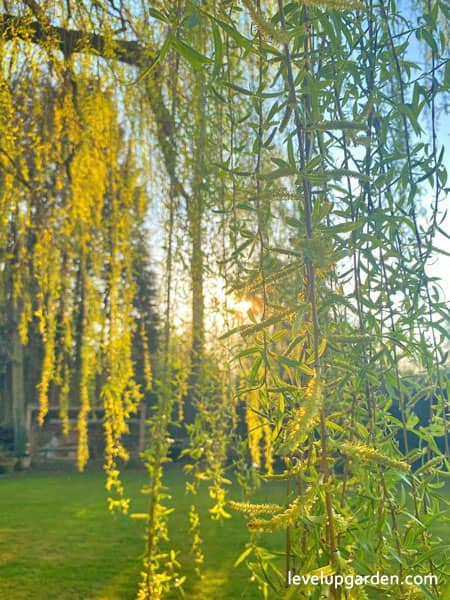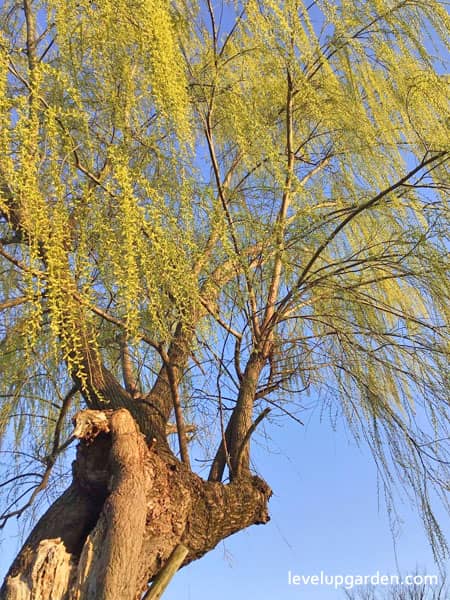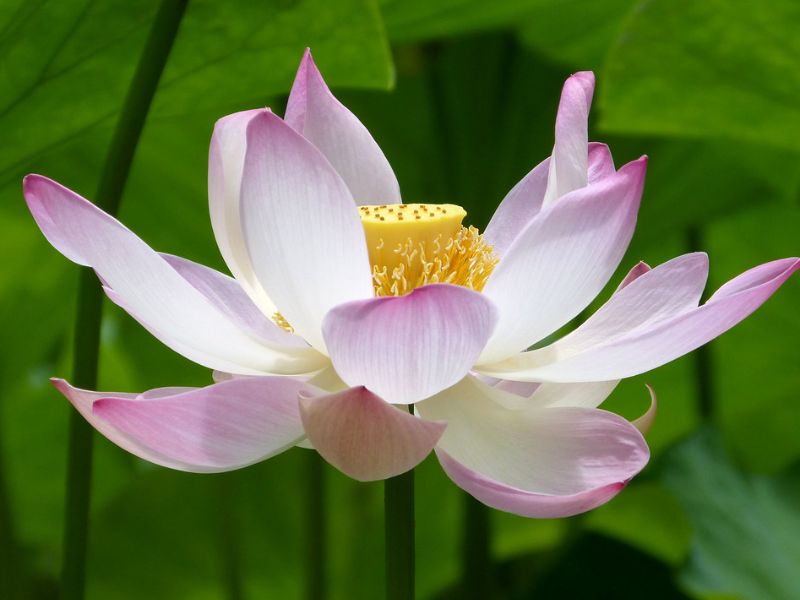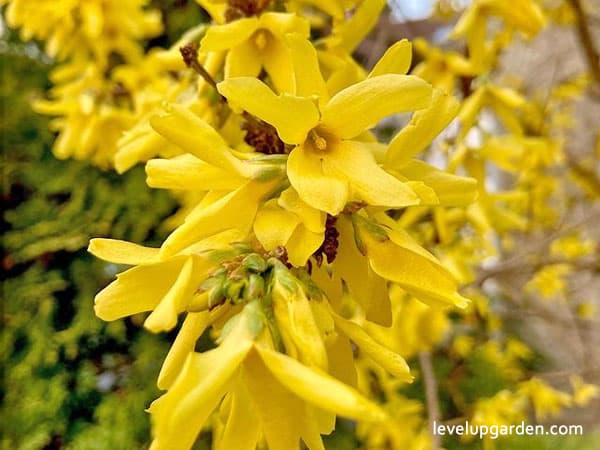Weeping Willow (Salix babylonica) is a large landscape tree with drooping branches, a short trunk, and an abroad, rounded canopy. It is native to East Asia but has become naturalized throughout North Carolina. It is one of the first trees to leaf out in the spring and one of the last to leaf out in the fall.

The weeping willow (Salix babylonica) is arguably the best known of the weeping willow trees, with its gracefully arching stems that hang delicately and sway in the wind. Read on to learn everything about the tree including its profile, appearance, growing condition, and the reasons you should or should not buy this plant.
I. Weeping Willow Profile – An Overview of the plant
A popular lawn tree, the willow is a medium to a large deciduous tree with graceful open branches reaching toward the ground on a sturdy trunk. It bears thin, lanceolate, finely toothed, light green leaves above and gray-green leaves below in spring and summer. They turn greenish-yellow in the fall, and when they fall to the ground they form a spectacular silhouette. Dioecious, the male and female flowers are each an inch (2.5 cm) long, delicate green catkins that bloom separately on male and female trees.

| Common Name | Weeping willow |
| Botanical Name | Salix babylonica |
| Plant Type | Deciduous, perennial, tree |
| Hardiness Zones USDA | 4 – 10 |
| Native Area | China |
| Toxicity | Toxic to animals |
| Mature Height | 35-50 ft. |
| Mature Width | 35-50 ft. |
| Growth Rate | Fast |
| Plant Family | Salix – Willows |
| Bloom Time | Late winter, spring |
| Flower Color | Yellow |
| Exposure | Full Sun |
| Water Needs | Average, High |
| Maintenance | Average |
| Soil Type | Clay, Loam, Sand |
| Soil pH | Acid, Alkaline, Neutral |
| Soil Drainage | Moist but Well-Drained, Poorly Drained |
II. Weeping Willow Appearance
- Leaf: It is one of the first trees to leaf out in the spring and one of the last to drop its leaves in the fall. The leaves are alternate, single, linear-lanceolate. They are 3-6 inches long, pointed at the tip, cuneate, and serrate. Leaves are deep green above and grayish-green below with narrow serrations and deciduous.
- Stem: In winter, the stems turn reddish-brown, which is interesting.
- Flower: 0.8″ long and 0.15″ thick catkin. It is not fancy.

III. Weeping Willow Growing and Care Conditions
Prefers sunny locations and moist soil. Works well when planted along the edges of ponds and lakes. In residential and commercial areas, rhizoids penetrate pipe cracks and multiply, clogging pipes and causing water back up, resulting in major repair costs. Often mislabeled in the nursery trade.
- Planting: Plant Weeping Willow in a sunny or semi-shady location (4-8 hours of sunlight per day), in well-drained soil, and at least 35 feet from a septic tank or leaching field. Dig a hole three times as wide and as deep as the tree’s roots when ready to plant. Place the tree in the hole, straighten it out, gently backfill the hole with soil and stomp it down. After this is done, water the tree slowly until the soil is moist. A layer of mulch about 3 cm thick around the base of the tree will help the soil retain moisture and prevent weeds from growing.
- Watering: During the first year, water regularly (once or twice a week) to keep the soil evenly moist. After that, water only during dry periods. Weeping Willow prefers moist soil but adapts easily to dry soil.
- Sun Exposure: A sunny location and partial shade are best; at least 4 hours of direct sunlight per day is required.
- Fertilizer: Choose a brand name or similar product that has equal amounts of each component, such as 10-10-10 or 20-20-20, for optimal results. Fertilizers that contain nitrogen will produce more lush plants and promote growth. Fertilizer should be applied in early spring before new shoots emerge.
- Soil Requirements: The plant can tolerate a wide range of well-drained soils and soil pH. Prefers moist, slightly acidic soils, but grows well in alkaline, loamy, fertile, sandy, and clay soils. If alkalinity is too strong, add organic matter to lower the pH.
- Temperature: The Weeping Willow has some drought tolerance and can handle the cold of winter. The tree can also withstand the heat of the desert in the summer as long as it has greenery and water.
- Pruning: Thinning the canopy improves airflow, pushes away wind, and helps prevent disease. A good rule of thumb is to prune about 2 inches between branches at the top of the tree in early spring before new shoots appear.
- Pests and Diseases: The weeping willow can be attacked by insect pests such as the mycorrhizal moth, aphids, and the hamamelid beetle. These pests are difficult to control, but targeted insecticide applications are effective, especially on larger trees. Young weeping willow trees are tempting to deer, elk, and rabbits, so be sure to put collars around young trees to protect them from wildlife. Several diseases and disorders can affect the tree, including willow beetles, crown gall, willow wilt, fungus, camphor, leaf spot, tar spot, powdery mildew, rust, and root rot. Symptoms include dead branches and twigs, defoliation, and in some cases, the disease can kill the tree. Healthy trees do not attract disease, so to minimize problems, it is important to keep trees healthy by providing adequate water. Raking up fallen leaves and removing them promptly will also help prevent the spread of disease. If these methods do not work, fungicides may be used.

IV. Weeping Willow Uses
The weeping willow is a beautiful and resourceful residential site in flood-prone areas. Weeping willow roots prevent erosion and protect irreplaceable topsoil.
The graceful form of the weeping willow is ideal for water features. Its beautiful appearance makes it a favorite among tree enthusiasts.
Weeping Willow contains tannins and salicin. It is used to treat mastitis, toothache, and burns. The plant has a long history in its native China. The bark has been used to treat rheumatoid arthritis, fever, and jaundice, while the leaves have been used to treat fever, skin rashes, and purify the blood.
V. Should I buy a Weeping Willow? Is this the tree for your garden?
Weeping Willow is a favorite of many tree lovers for its dramatic appearance and rounded weeping form. It is also ideal for those seeking a unique and classic look that will enhance the property value of your home. Weeping Willow is an excellent shade tree that is always in high demand.

It is also one of the fastest-growing shade trees, growing up to 6-8 feet in a year. Willow starts out as a thin tree with only a few branches pointing upward against the trunk. But as it grows rapidly to a height of about 3 meters, its branches grow rapidly and warp outward to form its famous weeping roof.
Greenwillow trees can remain healthy and lush as long as they have sufficient moisture. They soak up water like a sponge. They can tolerate short periods of drought and will grow in any soil.
Note that the Weeping Willow is not a suitable backyard tree unless you have a very large space. The tree itself can reach a height and spread of 45 to 70 feet and has extremely invasive shallow roots.
VI. FAQs
Where does a weeping willow grow best?
Weeping willow works best when planted in a sunny to a partially shaded location in slightly acidic, moist soil. Plant only in hardiness zones 4-10.
How fast does a weeping willow tree grow?
The weeping willow grows quickly. You can expect 3 to 4 feet of growth each year (older trees will slow down a bit). In wet years, there may be more.
Can I plant a weeping willow in my yard?
The weeping willow is not a suitable backyard tree unless you have a very large space. The tree itself can reach a height and spread of 45 to 70 feet and has extremely invasive shallow roots.







